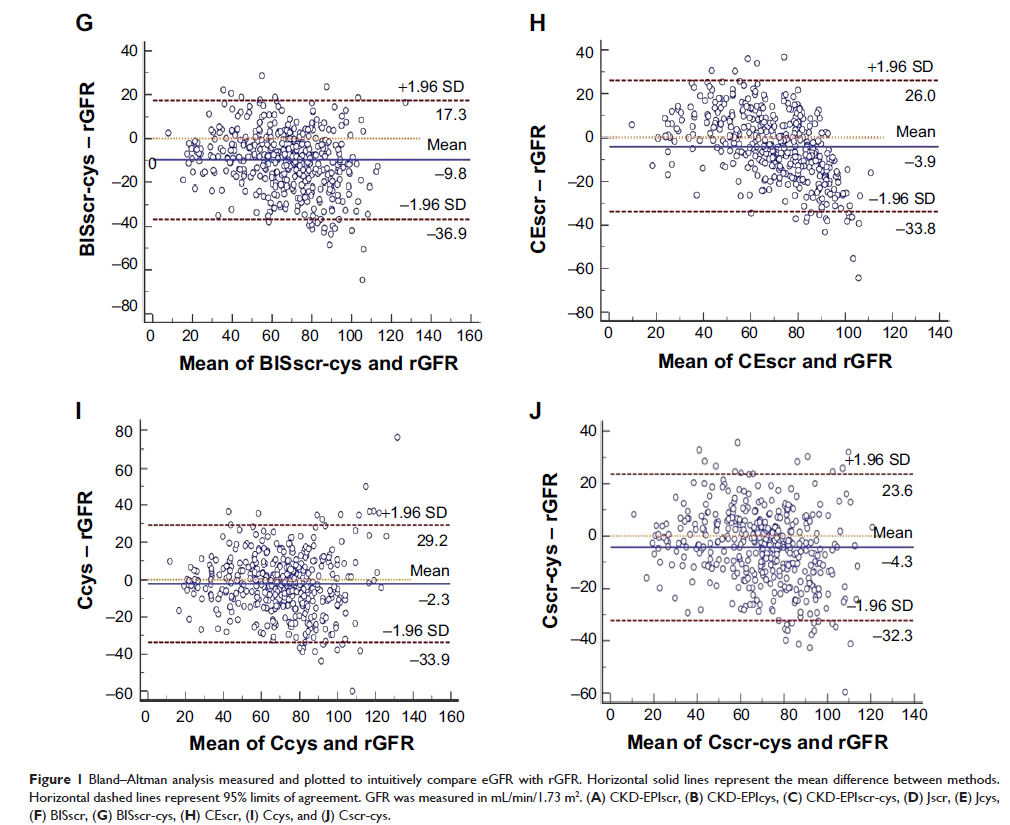109451
论文已发表
注册即可获取德孚的最新动态
IF 收录期刊
- 3.4 Breast Cancer (Dove Med Press)
- 3.2 Clin Epidemiol
- 2.6 Cancer Manag Res
- 2.9 Infect Drug Resist
- 3.7 Clin Interv Aging
- 5.1 Drug Des Dev Ther
- 3.1 Int J Chronic Obstr
- 6.6 Int J Nanomed
- 2.6 Int J Women's Health
- 2.9 Neuropsych Dis Treat
- 2.8 OncoTargets Ther
- 2.0 Patient Prefer Adher
- 2.2 Ther Clin Risk Manag
- 2.5 J Pain Res
- 3.0 Diabet Metab Synd Ob
- 3.2 Psychol Res Behav Ma
- 3.4 Nat Sci Sleep
- 1.8 Pharmgenomics Pers Med
- 2.0 Risk Manag Healthc Policy
- 4.1 J Inflamm Res
- 2.0 Int J Gen Med
- 3.4 J Hepatocell Carcinoma
- 3.0 J Asthma Allergy
- 2.2 Clin Cosmet Investig Dermatol
- 2.4 J Multidiscip Healthc

基于肌酐-和/或胱抑素 C 的肾小球滤过率估算公式在中国老人中的应用
Authors Ye XS, Wei L, Pei XH, Zhu B, Wu JQ, Zhao WH
Published Date September 2014 Volume 2014:9 Pages 1539—1549
DOI http://dx.doi.org/10.2147/CIA.S68801
Received 4 June 2014, Accepted 4 July 2014, Published 11 September 2014
Background: No conventional creatinine- or cystatin C-based glomerular filtration rate (GFR) estimation equation performed consistently outstandingly in elderly Chinese in our previous studies. This research aimed to further evaluate the performance of some recently proposed estimation equations based on creatinine and cystatin C, alone or combined, in this specific population.
Materials and methods: The equations were validated in a population totaling 419 participants (median age 68 [range 60–94] years). The estimated GFR (eGFR) calculated separately by ten equations was compared with the reference GFR (rGFR) measured by the 99mTc-DTPA renal dynamic imaging method.
Results: Median serum creatinine, cystatin C, and rGFR levels were 0.93 mg/L, 1.13 mg/L, and 74.20 mL/min/1.73 m2, respectively. The Chinese population-developed creatinine- and cystatin C-based (Cscr-cys) equation yielded the least median absolute difference (8.81 vs range 9.53–16.32, P <0.05, vs the Chronic Kidney Disease Epidemiology Collaboration serum creatinine equation), the highest proportion of eGFR within 15% and 30% of rGFR (P15 and P30, 55.13 and 85.44, P <0.05 and P <0.01, vs the Chronic Kidney Disease Epidemiology Collaboration serum creatinine equation), and the lowest root mean square error (14.87 vs range 15.30–22.45) in the whole cohort. A substantial agreement of diagnostic consistency between eGFR and rGFR (with a kappa 0.61–0.80) was also observed with the Cscr-cys equation. Moreover, measures of performance in the Cscr-cys equation were consistent across normal to mildly injured GFR strata and individuals aged ≤80 years. Among all the Cscr-cys equations, the elderly Chinese-developed creatinine-based (CEscr) equation performed best in this specific population. Nevertheless, none of the equations achieved ideal manifestation in the moderately to severely GFR-injured group or in individuals aged ≥80 years.
Conclusion: The Cscr-cys equation appeared to be optimal in elderly Chinese among the investigated equations. If cystatin C is not available, the CEscr equation is an acceptable alternative. A multicenter study with abundant subjects to develop an apposite formula for elderly Chinese is assumed to be essential.
Keywords: elderly Chinese, creatinine, cystatin C, glomerular filtration rate, equation
